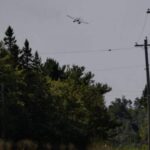The scorched landscapes of western Canada received their first significant reprieve this week as rainfall swept across regions devastated by early-season wildfires. After months of drought conditions and alarming fire activity, meteorologists are cautiously optimistic that the precipitation could mark a turning point in what has already become a challenging wildfire season.
“We’re seeing the first meaningful rainfall in areas that desperately needed moisture,” said Dr. Eleanor Williams, senior climatologist with Environment Canada. “While this won’t extinguish major fires immediately, it creates a crucial window for firefighting efforts to gain ground.”
The relief comes none too soon for provinces like British Columbia and Alberta, where hundreds of active fires have forced thousands of evacuations since early May. In northern Alberta, some communities have received between 20-40mm of rainfall—the equivalent of nearly a month’s precipitation in just 48 hours.
Fire management officials are tempering expectations while acknowledging the positive development. “This rainfall is significant, but we’re still early in what could be a very long fire season,” explained Marc Thibault, operations coordinator with the Canadian Interagency Forest Fire Centre. “The precipitation helps reduce immediate danger, but sustained moisture would be needed to meaningfully impact the deeper drought conditions.”
The weather patterns represent a marked shift from the unprecedented conditions that fueled early-season fire growth. May 2024 registered as one of the driest months on record across much of western Canada, creating tinderbox conditions that allowed wildfires to spread with alarming speed.
In British Columbia’s interior, where several major communities faced evacuation orders in recent weeks, the rainfall has allowed some residents to return home. Provincial authorities remain on high alert, however, as meteorological forecasts suggest the relief may be temporary, with warmer conditions potentially returning by mid-June.
The economic impact of this year’s wildfires has already been substantial, with preliminary assessments indicating losses in the billions across multiple sectors. Forestry operations, tourism, and transportation have all suffered significant disruptions, while air quality issues have affected major population centers.
Federal Emergency Preparedness Minister Harjit Sajjan emphasized the continuing national response during a press briefing in Ottawa. “While we welcome the rainfall, our government remains fully committed to supporting affected communities. We’ve deployed unprecedented resources to combat these fires and will continue coordination with provincial partners throughout the season.”
Indigenous communities, often at the frontlines of wildfire threats, have reported mixed conditions. “The rain helps, but our traditional territories have been deeply impacted,” said Chief Robert Nakogee of the Fort Albany First Nation. “We’re concerned about long-term effects on wildlife, water quality, and food security for our people.”
Climate scientists point to the wildfire situation as consistent with projections for Canada’s changing climate. Research indicates that warming temperatures create conditions for more frequent and intense fire seasons, particularly in boreal forest regions.
“What we’re experiencing aligns with climate models that predict increased fire weather conditions,” noted Dr. Sarah Takahashi, research director at the Canadian Climate Institute. “Even with this rainfall, the overall trend points toward more challenging fire seasons becoming the norm rather than the exception.”
As June progresses, emergency management officials are using the precipitation window to reposition resources and strengthen containment lines around priority fires. The Canadian Armed Forces continue to support firefighting operations in several provinces, with specialized equipment and personnel deployed to protect critical infrastructure.
For communities that have lived under evacuation orders or smoke advisories for weeks, the rainfall represents more than just fire suppression—it offers psychological relief. “Seeing rain again after so long gives people hope,” observed Dr. Michael Chen, a psychologist specializing in disaster response. “The constant stress of fire threat creates significant mental health challenges for affected populations.”
As Canadians look toward summer, a crucial question remains: is this rainfall the beginning of a weather pattern shift, or merely a brief interlude in what could become one of the most challenging wildfire seasons in recent memory?
























